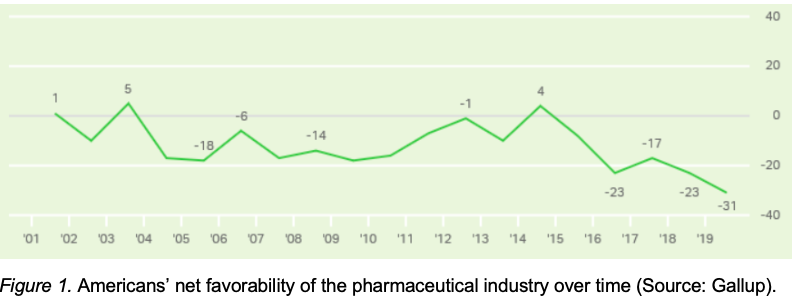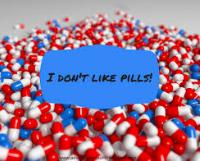Hear that? If you listen carefully, you may be able to catch the raucous cheers of lawyers, used car salesmen, and politicians all over the United States.
A recent poll from Gallup has found that the pharmaceutical sector is the most loathed industry in the country. It scored a net favorability rating of -31 points (27% positive, 58% negative), which is its lowest rating since the poll’s inception in 2001 (Figure 1). For comparison, advertising/public relations earned a (relatively) respectable net rating of -1 point, and the federal government came in at -27 points.

What’s going on? On its face, you may not have expected that our most reviled industry is one whose mission is to save lives and alleviate suffering from disease. Not only that, but broadly increasing life expectancies, lower rates of mortality from many diseases, and other indicators suggest that Big Pharma does a pretty good job of achieving those goals.(1)
If only the story were that simple. Pharma’s image has been battered by a variety of misconceptions, but it’s also suffered from plenty of legitimate scandals and self-inflicted wounds. To help keep track of everything, let’s dissect some of the factors—both the sensible and the nonsensical—that are driving the embarrassingly bad reputation of the pharmaceutical industry to even greater depths.
1. Drug prices are astronomically high…and they’re getting higher all the time
Drug pricing has been a contentious topic for decades, but that hasn’t prevented pharmaceutical companies from continually raising the prices of both new and existing medicines. From 1997 to 2007 and 2012 to 2017, the cost of prescription drugs increased by roughly 10% every year, which corresponds to a doubling in price every ~7 years. More recently, several of the country’s most expensive drugs have been approved, including Zolgensma (#1, $2.125m) and Soliris (#5, $678,392) within the past few months. Accompanying these rising costs has been a robust debate—which ensnared yours truly earlier this year—over whether they’re justified. There are reasonable claims to be made on both sides, but I won’t relitigate those points here.
Unfortunately, several recent examples of egregious, indefensible price-gouging have tarred the entire industry. “Pharma Bro” Martin Shkreli infamously raised the price of the life-saving drug Daraprim by over 5,000% after purchasing its marketing rights in 2015. Similar controversies regarding Valeant Pharmaceuticals (now Bausch Health) and Mylan (the producer of EpiPen) have given the public the idea that drug companies are profiting off human suffering. That type of behavior is (thankfully) the exception rather than the norm, but it does happen. And when it does, we all lose.
2. Patent acrobatics sometimes push the boundaries of legality
One of the main reasons why companies can charge such high prices is the rip-roaring practice of patent law.(2) The federal government incentivizes innovation by providing drug companies with patents that prevent all other firms from selling a particular drug for a few years. With no competition in town, companies can charge monopoly-level (i.e. very, very high) premiums for their product.
This patent-protected window is so valuable that firms can go to great lengths to try to keep it open for as long as possible. The company AbbVie, for example, is being sued for erecting a “patent thicket” comprising >100 patents to protect its drug Humira (the best-selling drug in the world) from generic competition. A more…err…creative situation came from Allergan, who attempted to skirt the system by transferring one of their patents to the Saint Regis Mohawk Tribe. The claim worked its way up through the legal system before being swatted away by the Supreme Court earlier this year. Needless to say, the general public has not been amused.
3. The origins of the opioid crisis can be traced to prescription drugs
The number of Americans dying from prescription and illicit opioids is staggeringly tragic and represents one of the most pressing public health challenges we currently face. ACSH and Dr. Josh Bloom have been discussing this topic in great detail for several years, so I’ll only touch upon it briefly.
As the word “prescription” in the previous paragraph suggests, a clear line can be drawn between the pharmaceutical industry and the beginning of the crisis (at the very least). In particular, the manufacture and aggressive marketing of the opioid OxyContin by Purdue Pharma has earned the company a boatload of potentially bankruptcy-inducing lawsuits.
Additionally, Johnson & Johnson was recently fined over half a billion dollars for its deceptive marketing practices surrounding opioid painkillers in Oklahoma. J&J isn’t in the same class as Purdue because it’s primarily a supplier of raw materials (e.g. opium poppies) used to make opioids—its own drugs account for <1% of opioid prescriptions. But people are understandably distressed by the damage that opioids have wrought. The pharmaceutical industry is an easy target, and there’s plenty of blame to go around.
4. Most people don’t know how challenging and costly making a new drug can be
As I and many others have written before, science is hard…and it’s even more expensive. But most people have no clue that that’s the case, and they certainly don’t know why. Unfortunately, these misunderstandings are neither benign nor inconsequential. Ludicrous conspiracy theories regarding hidden cures for cancer or dangers of genetically modified foods are often rooted in ignorance of basic science. And the belief that pharmaceutical companies mooch off taxpayer-funded academic research while reaping all its rewards bears no resemblance to the actual drug discovery process.
This last point presents a golden opportunity for us scientists to help restore the reputation of our industry. We may not have control over the consultants that our colleagues hire, but we can reach out to the general public and talk about our science in ways that non-specialists can comprehend. If more people understand what we do, then we can have more productive conversations on how to make the whole system work better for everyone. After all, knowing is half the battle.
NOTES:
(1) It does so in collaboration with the healthcare industry, of course…but healthcare also scored a meager -10 points.
(2) You think I’m being sarcastic, but just wait until you see what the lawyers have been up to!




